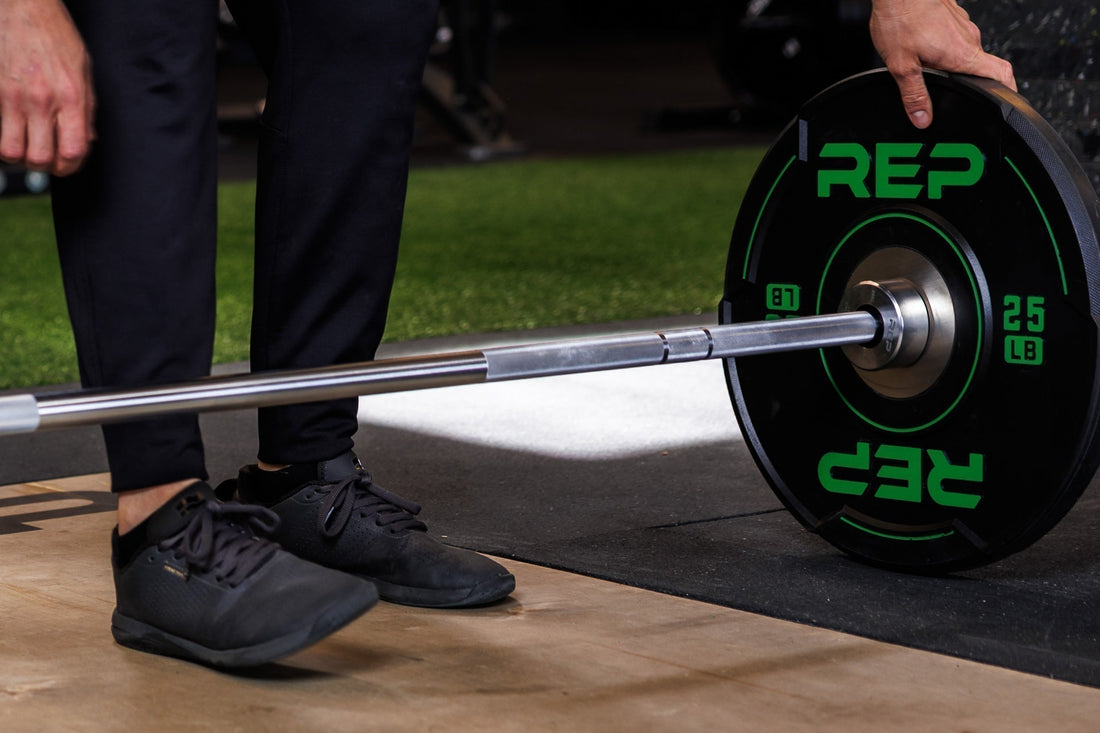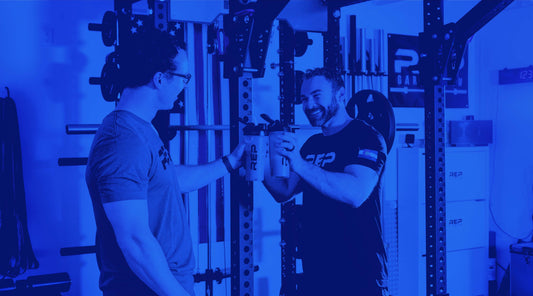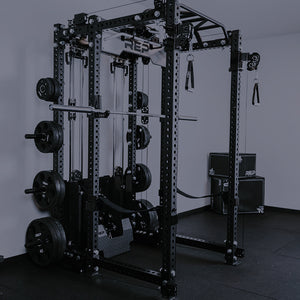
Light up them hammies.
Don’t be the weirdo in the gym with huge quads and an embarrassing backside. You know the look: all business up front, party never in the back. If your hamstrings and glutes are lagging behind like they missed the gains train, it’s time to learn how to do a barbell RDL (Romanian deadlift).
This compound lift doesn’t just hit your hamstrings and glutes — it also puts the heat on your lower back, forearms, and grip. A stronger, more powerful posterior chain supports your squats and deadlifts, helps your pants fit better, and aids both athletic performance and everyday life.
How to Do a Barbell RDL
Follow this step-by-step guide to lock in proper barbell Romanian deadlift form and fire up your posterior chain.
-
After a proper warm-up, stand tall with an overhand grip on the barbell. The bar should be in front of thighs, feet hip-width apart, with a slight bend to your knees. Pull your shoulders back and engage your core.
-
Breath in as you hinge at the hips, sending you butt back while keeping the bar close to your legs as it lowers.
-
While maintaining a neutral spine, lower down to about mid-shin — you should feel a solid stretch in your hamstrings.
-
Breath out as you squeeze your glutes, drive through your heels, and send your hips forward to return to standing.
Pros and Cons of Barbell RDLs
While you can hit your RDLs with a barbell, dumbbells, kettlebell, or even a sandbag, each tool has its own benefits — here's when a barbell might be the right or wrong choice.
PROS
- Simple progressive overload: Adjusting weight is quick and precise — just slide on more plates when you're ready to lift more.
-
Stability: As you load on more weight, the barbell allows you to maintain a balanced and secure grip compared to bulky dumbbells or kettlebells.
- Better suited for max strength: Ideal for low-rep, high-load training where the goal is building max strength.
CONS
- Less stabilizer activation: Compared to holding two separate weights, or a sandbag (where the load shifts as you move), the stability that a barbell offers limits some recruitment of your smaller stabilizer muscles.
- Limited range of motion: While the RDL typically stops around mid-shin, if you've got some impressive flexibility and need to lower down further, the weight plates on a barbell may keep you from doing so.
TL;DR: Use a barbell when you want to lift heavy and progressively overload, dumbbells for more range of motion and unilateral balance, a kettlebell when learning the mechanics of a hip hinge, and a sandbag for functional training and stabilizer strength.
How to Choose A Barbell
If you've got your pick of the litter — or you're wondering which barbell to add to your home gym — here's how to navigate your options depending on training goals, experience level, and how you want the movement to feel:
Standard Barbell: This is the most common bar you'll find in commercial gyms and the go-to for your typical lifter. Great for RDLs as well as squats, deadlifts, bench press, rows, landmine moves, and more. Check out our all-purpose Colorado™ Bar.

Trap Bar (Hex Bar): The hexagonal frame of a trap bar distributes weight around your body instead of just infront, like with a standard barbell. This shape allows for a more upright position which can limit lower-back stress — great for those with mobility issues, rehabbing from injury, or anyone learning/improving their RDL and deadlift form.
Open Trap Bar: Similar to a trap bar but with an open side, allowing more freedom of movement. It supports a more natural hip hinge and works well for lunges, split squats, rows, and more. The REP Open Trap Bar even features a built-in jack that makes loading and unloading the plates easier.

Deadlift Speciality Bar: If deadlifts are your focus, a speciality bar like the Hades™ Deadlift Bar is designed to flex slightly, allowing the lifter to pull from a slightly higher position — which can contribute to potentially lifting more weight. However, these bars are better suited for heavy deadlifts rather than RDLs.
Technique Bar: These bars — like the Mesa™ Technique Bar — are lighter and shorter than a standard barbell, making them ideal for beginners who are learning new movement patterns.
Cambered Swiss Bar: To the uninitiated, this bar may sound like a block of cheese, but it's actually a versatile multi-grip barbell that offers a unique grip and pulling angle. The cambered (curved) handles add a bit of instability, requiring more stabilizer engagement to maintain control throughout your lift. Check out our write-up on everything you can do on a cambered swiss bar.

Barbell RDL Common Mistakes to Avoid
While the move looks simple enough, it’s important to avoid the following form flubs to make sure you’re targeting the right muscles and steering clear from injury.
Distance From the Bar
In an RDL workout, as you lower and lift, the bar should slide up and down your legs — like a close shave. If it swings out and away, it pulls your weight forward and can put unnecessary stress on your lower back.
Rounded Back
A neutral spine — aka a flat back — keeps your spine in its natural alignment and is the safest and strongest position for loading your hamstrings and glutes without stressing your lower back. Rounding your back to move the weight not only limits core and hamstring engagement, it’s also a one-way-ticket to lower back pain. You can also toss on a lifting belt to help you keep your core braced and spine neutral.
Going Too Low
Lower down until you feel a stretch in your hamstrings — usually around mid-shin — then come back up to standing. Going lower just to go lower can force you past your flexibility limits and lead to back rounding, especially under load.
Head Tilt
Spine alignment is the name of the game during RDLs, and that includes your neck. Keep your chin slightly tucked from start to finish. (Sorry, no checking yourself out in the mirror at the bottom of the lift. Eyes should be on the floor.)
Barbell RDL Modifications and Progressions
Proper barbell RDL technique isn’t easy to master, so we talked with strength coach Dan Berman, CSCS, NSCA, about modifications athletes can use to perfect their barbell RDL form.

“It’s challenging to keep a neutral spine,” says Berman. “So, for those looking to nail their form, start out with a dowel or training bar placed across your shoulders like you would for a back squat. This allows you to perform the movement while helping maintain proper spinal alignment.”
If you’re new to the move or are coming back from injury, Berman also recommends banded RDLs. “Step onto a super band and place the other side over your shoulders. This joint friendly option will help your hips move back in the hinge and requires you to brace your core to keep a neutral spine, supporting core engagement awareness.”
When working up to a barbell RDL, you can also start with kettlebell or dumbbells to get comfortable with the movement.
When You’re Ready, Try These Progressions:
Tempo RDLS: Take 3-5 seconds to lower down during the eccentric phase, then power back to standing. Slowing it down increases your time-under-tension while also building strength, control, and some serious hamstring burn.
Single-Leg RDL: Unilateral work, like the single-leg RDL, is a great way to identify and correct muscle imbalances. Stand on one leg with a slight bend in the knee. As you hinge at the hips, send your free leg back as your torso tips forward. Once you feel that stretch in your hamstring, drive through your grounded foot to return to standing.
Berman recommends beginners start off doing bodyweight single-leg RDLs, then once the movement pattern is dialed in, progress to holding a dumbbell in the opposite hand.
Barbell RDL Vs. Deadlift
The Romanian deadlift and the deadlift may look similar, and both target the posterior chain — but the way they load and work the body is different.
The RDL primarily hits the hamstrings, while the conventional deadlift puts more emphasis on the glutes and back. Think of the deadlift as a combo of a hip hinge and a squat, while the RDL is a pure hip hinge — no squat involved.
“The deadlift starts with a concentric movement with the pull from the ‘dead’ position on the floor,” says Berman. “Repetitions with the RDL begin with an eccentric movement that stops about mid-shin.”
Because of this, the conventional deadlift typically uses a larger range of motion, starting from the ground and finishing in a full lockout.
One more key difference? Load. Most lifters can pull significantly more weight in a conventional deadlift than they can in an RDL. So be sure to adjust accordingly when switching between the two.
Barbell RDL Benefits and Muscles Worked
The barbell RDL doesn't just light up your hamstrings — it hits all the right spots along your backside. Here's a quick breakdown of the muscles doing the heavy lifting.
- Hamstrings – the main movers. They lengthen and contract through the hinge to drive the lift.
- Glutes – in charge of that hip hinge.
- Erector Spinae (muscles along your spine) – keep your back stabilized.
- Abs and Obliques – keep your spine safe by bracing your core and transferring power.
- Forearms and Grip – fight to hold onto the bar.
Takeaway
Barbell RDLs may not be the flashiest lift in the gym — no one’s crowding around to watch your mid-shin hinge — but among coaches and seasoned lifters, they’re a non-negotiable. Few moves light up your hamstrings, glutes, and posterior chain like this one.
Master the form, keep the bar close, and trust the process. Whether you’re training for performance or aesthetics, RDLs deliver.
And if you’re curious about how to pick the right barbell for you RDL routine, check out our Barbell Comparison Guide.
FAQs
What’s the difference between a barbell RDL and a regular deadlift?
Think of the RDL as the top half of a regular deadlift. The RDL starts from the top and focuses on the lowering (eccentric) phase of the movement, while a standard deadlift starts from the floor and works through a larger range of motion. Because of this, the RDL targets the hamstrings more, while the deadlift hits the glutes and back harder.
Should the bar touch the floor during a barbell RDL?
Once you start your RDL reps, the bar shouldn’t touch the ground until your set is done. The bb should lower to about your mid-shin before you send your hips forward and come back to standing.
How to do RDLs with a barbell for beginners?
Start off by mastering the form before you load up the bar with weight plates. Set your feet hip-width apart and maintain a soft bend in your knees. Start with the barbell gripped in your hands in front of your thighs, then lower it down to your mid-shin, keeping it close to your legs. Maintain a neutral spine — no rounding or arching — and drive your hips forward to come back to standing.
Should my knees be locked or bent during a barbell RDL?
You want a soft bend to your knees during this hip hinge exercise. This’ll keep tension in your hamstrings while allowing your hips to move freely.
Why do I feel barbell RDLs in my lower back?
While your lower back does work to stabilize your spine during the move, feeling pain, discomfort, or your back working over-time usually points to form issues. Be sure to brace your core, maintain a neutral spine, and make sure you’re not going too low. A rounded back will take the work away from the hamstrings and place it on the back.
Rosie Borchert is NASM-CPT, former Nike Volleyball coach, and fitness writer whose work has appeared on BarBend and Tonal. If anyone would like to hire her to play beach volleyball, snowboard, binge watch TV, or go climbing, please get in touch.
This article was reviewed by Ashley Boyer, ACE-CPT, for accuracy.
similar to this

NEWSLETTER SIGNUP
Product launch information, promotions, blogs, and REP news.







